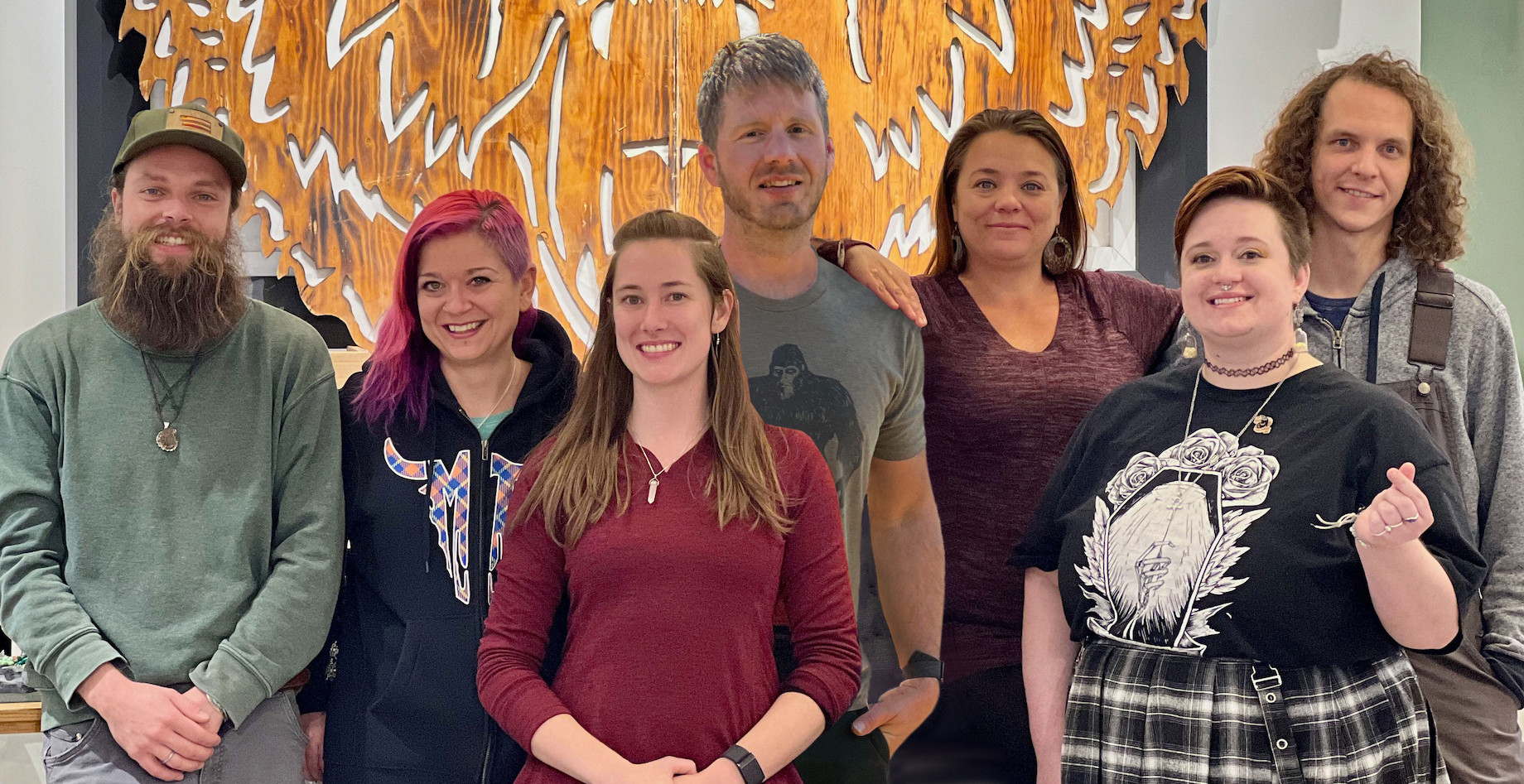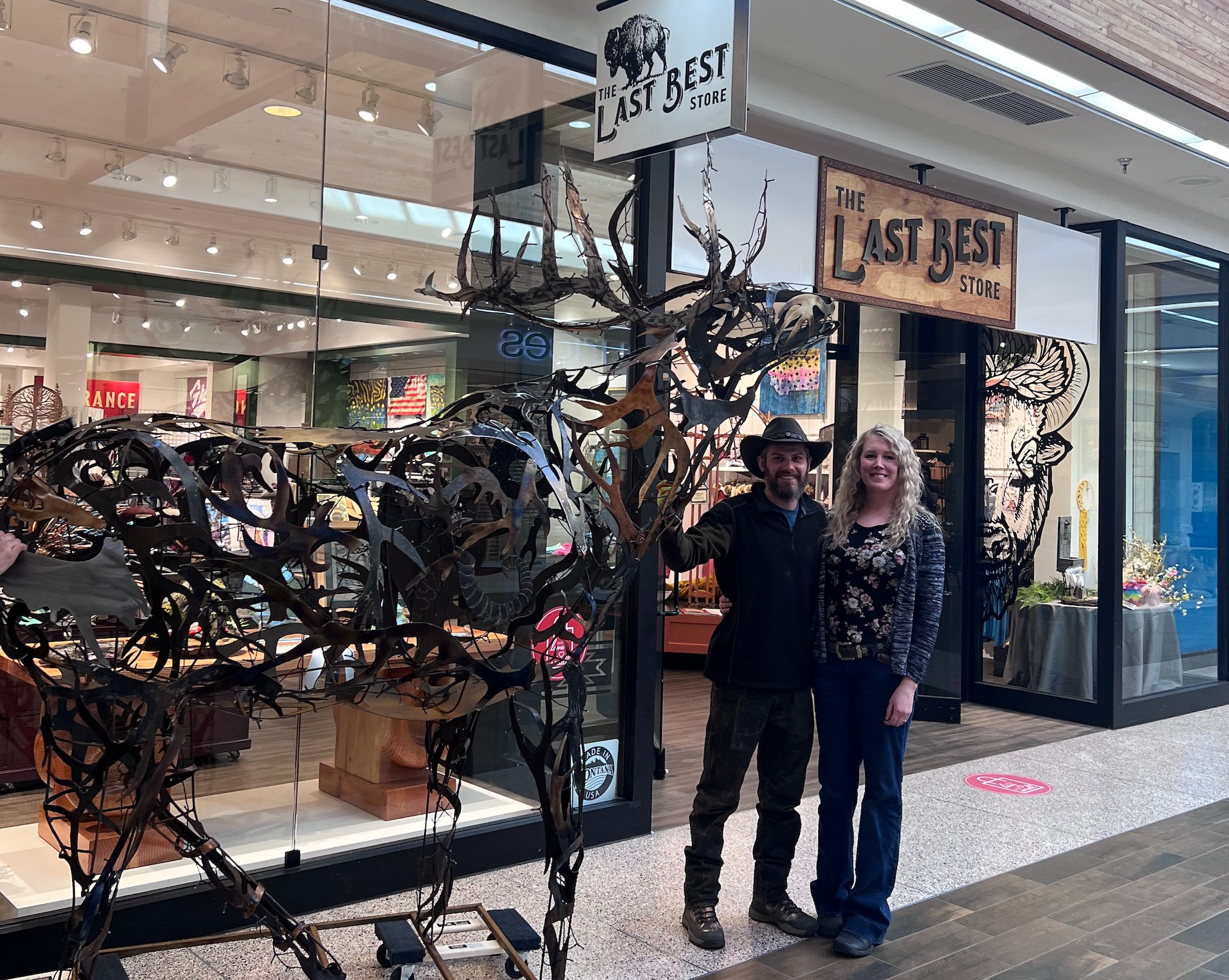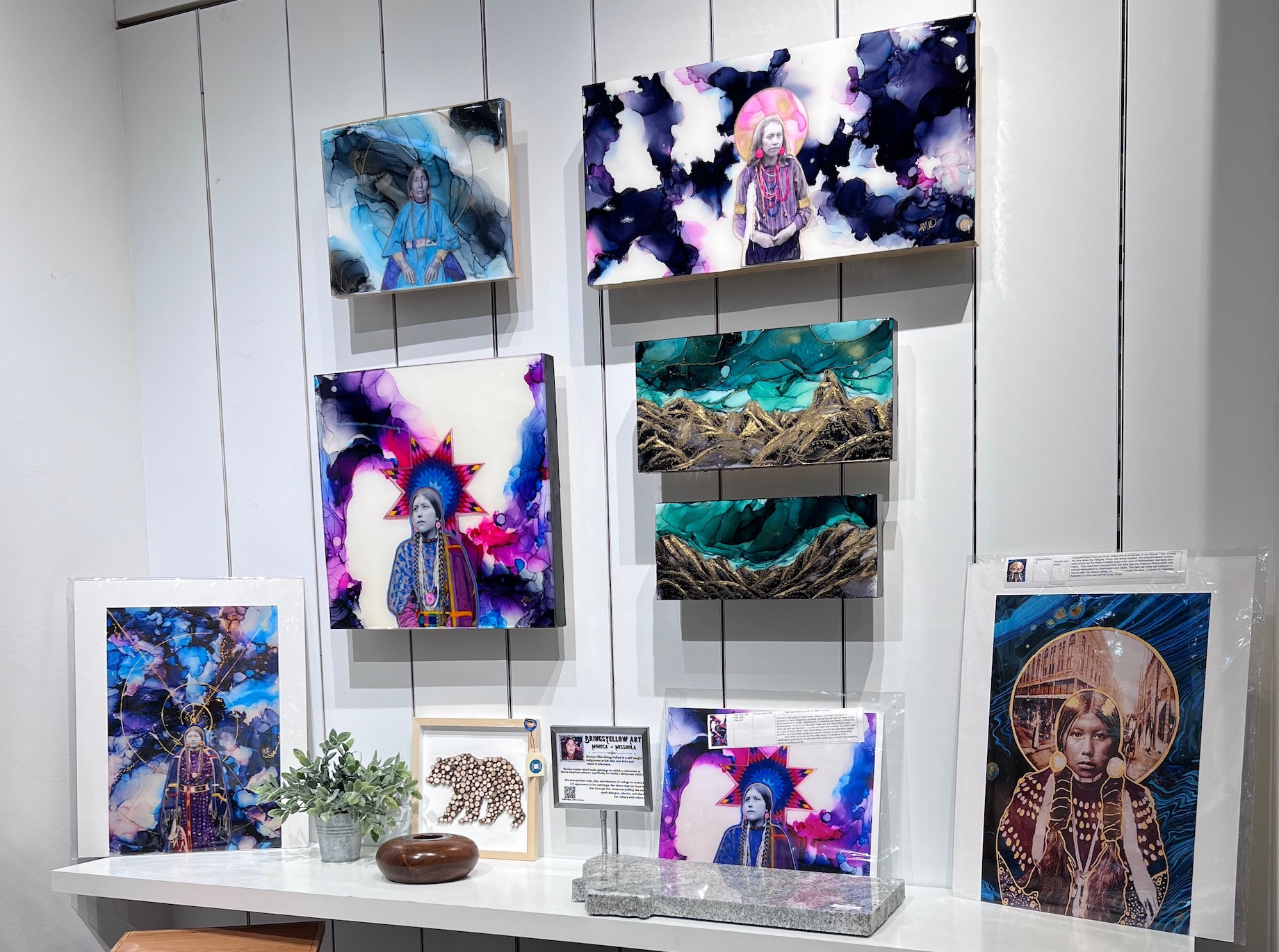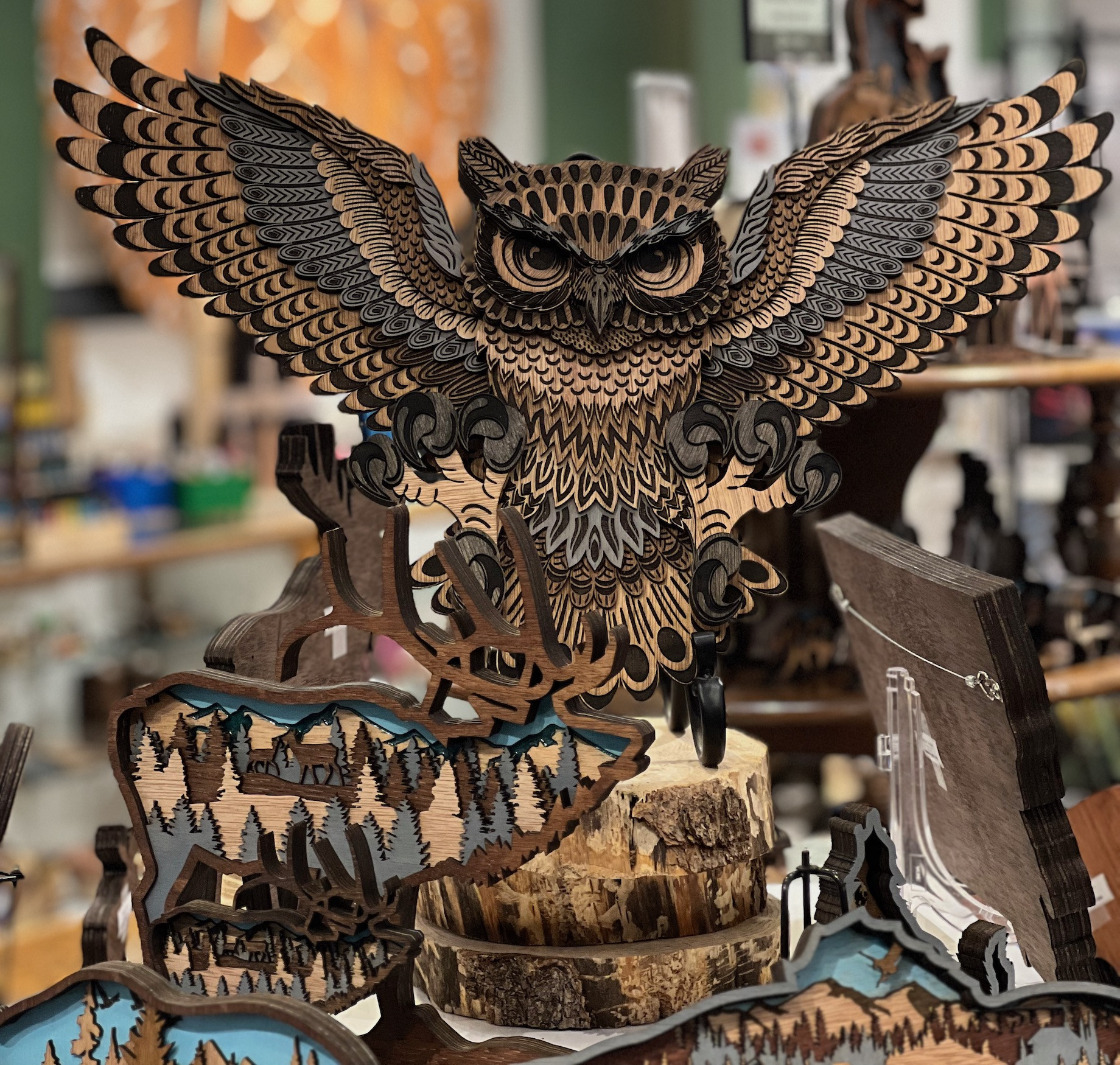Designers, artists and manufacturers Brooke and Alex Blackler make customizable items like baseball hats riveted with laser-etched wood patches and T-shirts printed with gold foil. Brooke, 33 and Alex, 35, have been a staple at art and trade shows throughout the state for more than a decade. In that time, they’ve come to know and admire many other Montana artists and businesses. “It is a very supportive community,” Brooke said.
When a leasing manager at Southgate Mall in Missoula saw the spouses’ Instagram posts in 2021 and reached out about a vacant spot in the mall, Brooke said: “I figured it’s very hard making online sales, so why not go in and see what it’s like?” When they walked into the store, though, they were shocked at the cavernous 4,800 square feet. “I was like: ‘Um, do you guys have anything smaller?’” Brooke recounted.
When the leasing manager said no, Brooke pivoted. The store was too big to feature just the Blacklers’ products, but the community of Montana artists and businesses also could benefit from a permanent, physical location to sell their work. “I decided: ‘Alright, I’m just going to start calling everyone I know from the People’s Market [a Missoula art show], the Made in Montana Tradeshow and the vendor community that we’d built up over a decade of vending to see if they’d be interested,” she said.
Twelve other makers were. The Last Best Store opened before the holiday season in 2021 to much buzz. The name is a shoutout to Montana’s nickname as the Last Best Place, and the store features unique, often Montana-centric, products from more than 120 Montana artists and businesses like wild huckleberry jam, embroidered University of Montana beanie hats and Griz claw earrings, a reference to the University of Montana Grizzlies. “We love that we’re able to elevate a local community in a normally corporate environment,” Brooke said.
And while Brooke and Alex always have believed in their mission, it was a surprise when the Montana Department of Commerce named the store Retailer of the Year.
Below, Brooke talks with Small Business Center contributing editor Rebecca Meiser about the couple’s connections to Montana, how she finds artists to feature, the unexpected challenges of running a small business and her hope of showcasing Montana artists and businesses to the rest of the country.

The impactful staff who make up The Last Best Store team, from left to right: Theo Bullock, Katie King, Brooke Blackler, Alex Blackler, Sonnie Tate, Em Cohen and Danny Iverson
What is your connection to Montana? Why is it such a focus for you?
Alex and I were born and raised in Missoula. He is a sixth-generation Montanan. I am fifth generation. We’ve both always loved it here, from the mountains and streams to the people. I’ve traveled, experiencing various communities, including staying in a third-world country for my freshmen year of school. Coming back to Missoula has always felt good, like home. I deeply appreciate it here and want to build a business that gives back to the community.
Opening The Last Best Store had never been a long-term plan for you, and the deal happened kind of suddenly. What sort of lease did you sign and how did you finance it?
We signed a three-year lease. My rent is a base payment and then I pay an additional 15% of sales over a certain amount, so we have an overage fee for when we make more money. But in terms of financing, everything has just been bootstrapped completely. I borrowed some money from family and friends. Then I just dove in. We’re just trying to work through it still.
Part of the success of the store is the merchandise you carry. How do you find artists and businesses to feature?
We started off with 12 other businesses and artists besides us, just friends that we’ve made through the years. Now, if I’m vending at the market or trade show, I’ll go and I’ll introduce myself to people. If their product seems like a good fit, I’ll invite them to apply. I also go onto the website of Made in Montana [a state program that assists Montana businesses in developing and marketing their products], and I look through other business listings. I also look on Instagram and follow Made in Montana hashtags to see what other people are creating and what other artists are out there who might want to be involved. We’re also at the point now where people come to us. I have people coming in the store all the time with applications, wanting to be involved.
Do you sell products online, too, or only in the store?
We do sell online. I have been working on building the website and getting as many people’s stuff on there as I can. It is a huge undertaking, though, with so many different vendors and so many different SKUs. We’re just chipping away at it, trying to start with things that are the most regular. A jam, for instance, that comes packaged the same every time is easier to sell [online] than someone who makes a completely unique product that varies every single time. But we’re working out the kinks. Eventually, I’d love to become one of the best largest Montana-made online stores out there selling Montana to the nation or the world, even.

Metal sculpture artist Laura Jean Newby — based on Conner, Montana — and her husband move one of her welded creations into The Last Best Store.
What does the application look like? What questions do you ask?
I want to make sure they’re part of Montana. My goal is also to elevate the Montana manufacturing scene. I do want the products to be made in Montana. Then I ask them for social media or websites so that I can view their products. I ask them what kind of things they make. We don’t want the exact type of things in our store, like if someone says they make gnomes — well — we already have someone in our store making handmade gnomes. Then I make sure that they are aware that it’s a consignment agreement, and I give them a form that explains everything that we do for them and what’s expected of them and how long they’ve been in business.
How do payouts and consignment work for the artists and businesses in your store?
It’s a 60/40 split with 60% in their favor paid out once a month by the 15th of the following month. I originally was offering people payment through Venmo and PayPal, but that became very hard to track through my QuickBooks because you don’t get a statement from Venmo and it only goes back a certain amount of time. So trying to do any retroactive transactions — it was just very complicated. Also, they won’t let you do many large amounts in a row, and I didn’t realize that. In December [2022], I started trying to make these large payments to people, but I had a ton of issues. That was pretty stressful because I was trying to get people paid on time, but everyone was really understanding. I think communication is so key. And I’ve found this other system that I’ve been using now — bill.com — and that has been a lot better. It links to QuickBooks and allows me to pay via check or direct deposit.
Are you profitable?
No. I’m hoping this year will be our first profitable year. We implemented a box business, as well. It’s called The Last Best Box. It also features all Montana-made businesses. We offer either a bimonthly subscription or the box as a corporate gifting item. We’re able to then take more of the people’s stuff that are in our store, get them into boxes and ship them out all over. People get a deal if they buy more than one month’s worth of boxes at a time.
How do people find you?
Honestly, my marketing is not super great right now. That’s one of my weak points for sure. I have a small email list, and then I think the affiliate network [in which The Last Best Store offers nonprofits commissions on sales] will be a really big, key part moving forward. It’ll be more of a grassroots method of getting our name out there.
Tell me about the Montana Retailer of the Year award. How does it work? Did you apply yourself?
We didn’t apply. It’s all nominations from people who are part of the Made in Montana program. When you sign up to do the Tradeshow, you get the option to nominate a retailer for a retailer of the year. We weren’t expecting anything at all. It was a huge validation of everything that we’re doing and building, especially because it does get really hard sometimes when finances are really low and we’re just trying to keep people employed and trying to get through the slow time. When January hit, for instance, that was really difficult, so to get that award in March really created a lot of good feelings around everything that we’re doing.
Why do you think your concept works? Why do you think people respond to it?
It works because what we’re trying to do really benefits the community as a whole. I think that during COVID, people more than ever before started to look at small businesses and the value that they bring. Since that time, we’ve seen that trend continue, with people wanting to support small, local creators. Creating a platform where that is everything that we do not only fits with the trends that we’re seeing in the nation but also feels right and good in the community.

Monica Gilles-BringsYellow, who grew up on the Flathead Indian Reservation within Montana, frequently incorporates photos of Indigenous women into her artwork, which is sold in The Last Best Store.
Where do you want to be in 10 years?
In 10 years it’d be really awesome to have multiple stores. If we could take this model and iterate it in other cities, where we can get more of the very local people involved and continue working with nonprofits, that would be amazing. That’s really what I would love to see: a multistore model where we have even more creators involved and more nonprofits that we can represent.

RSJ Engraving is among the creative ventures that sells its work in The Last Best Store.
By Rebecca Meiser
Contributor, Commerce + Communities Today and Small Business Center